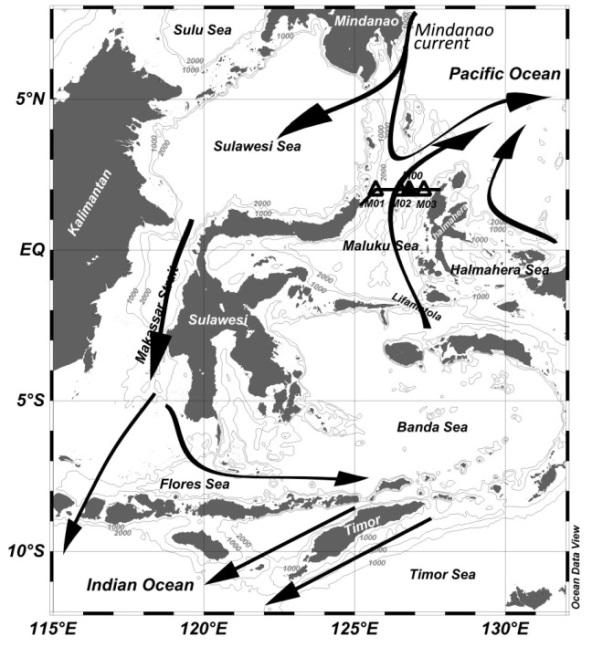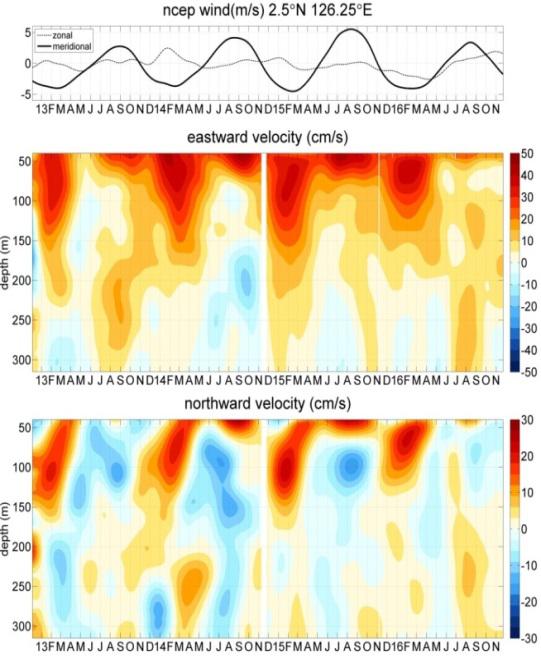Chinese scientists has made significant breakthrough in the study of the Indonesian Throughflow
Recently, the Journal of Physical Oceanography of the American Meteorological Society, which is one of the most prestigious academic journals in the physical oceanography research of the world, has published an important research paper led by Chinese scientists on the variations of the Indonesian Throughflow under the influence of the western boundary currents (Yuan et al. 2018). The achievement is made jointly by the scientists from the Institute of Oceanology of the Chinese Academy of Sciences (IOCAS), including Professor Yuan Dongliang and his team, from the Research Center for Oceanography of the Indonesian Institute of Sciences (RCO-LIPI), and from the Max-Planck Institute für Meteorology of Germany.
Based on four consecutive years of subsurface moorings observations in the Maluku Channel of the Indonesian Seas, the upper-ocean circulation in the Maluku Sea has been observed for the first time in history, showing a mean northward transport to the Pacific Ocean of about 1.0 Sv, clarifying the ambiguity of the traditional understanding of the upper-ocean circulation in the area. The observations unravel a significant southward increase of the Indonesian Throughflow during the spring and summer of 2014, with a total transport of 14 Sv, of which 3.5 Sv are the interannual variability. These variations were significantly different from the response of the local circulation to the wind forcing and were suggested to be induced by the shifting of the Mindanao Current in the Pacific Ocean. The variations of the Indonesian Throughflow may have an inhibitory effect on the onset and development of the El Ni?o event in 2014.

FIG. 1. Schematic of the upper-ocean circulation of the Indonesian Seas. Solid and empty triangles mark the positions of the 2012–2014 and 2014–2016 mooring positions, respectively. The solid line across the Maluku Channel indicates the section of the normal transport calculation.

FIG. 2. (a) NCEP winds and the (b) zonal and (c) meridional components of the moored ADCP velocity time series at M00 in the Maluku Channel during December 2012–November 2016.
The observations in this paper suggest that the interactions between the Rossby waves and the western boundary currents could cause the Indonesian Throughflow to vary significantly, providing solid evidence for the nonlinear reflections of the Rossby waves at the Pacific western boundary. Yuan Dongliang has discovered that the nonlinear reflection of Rossby waves at the western boundary is significantly different from the classic linear theory nearly 15 years ago, but has suffer from no observational data at that time. They have conducted theoretical analysis of the multiple equilibria and hysteresis dynamics of the western boundary currents flowing across a gap (Yuan and Wang, 2011; Wang and Yuan, 2012), which lays a foundation for analyzing the mooring data in the Maluku Sea. Their collective research results under the umbrella title of "Dynamics of the exchange between the Pacific western boundary currents and the marginal seas" have been awarded the tier-2 natural science prize of the Shandong province. The above innovative researches have laid a solid theoretical and observational foundation for the study of nonlinear dynamics of the western boundary currents in the Pacific Ocean.
1. Yuan D., Li Xiang, Wang Zheng, Li Yao, Wang Jing, Yang Ya, Hu Xiaoyue, Tan Shuwen, Zhou Hui, Adhitya Kusuma Wardana, Dewi Surinati, Adi Pureandana, Mochamad Furqon Azis Ismail, Praditya Avianto, Dirham Dirhamsyah, Zainal Arifin, Jin-Song Von Storch, 2018: Observed Transport Variations in the Maluku Channel of the Indonesian Seas Associated with Western Boundary Current Changes, J. Phys. Oceanogr., 48(8), 1803-1813.
2. Wang, Z., D. Yuan, 2014: Multiple equilibria and hysteresis of two unequal transport western boundary currents colliding at a gap. J. Phys. Oceanogr., 44, 1873-1885, doi: 10.1175/JPO-D-13-0234.1.
3. Wang, Z., and D. Yuan, 2012: Nonlinear Dynamics of Two Western Boundary Currents Colliding at a Gap. J. Phys. Oceanogr., 42(11), 2030-2040.
4. Yuan, D., and Z. Wang, 2011: Hysteresis and Dynamics of a Western Boundary Current Flowing by a Gap Forced by Impingement of Meso-scale Eddies. J. Phys. Oceanogr., 41, 878-888, doi: 10.1175/2010JPO4489.1